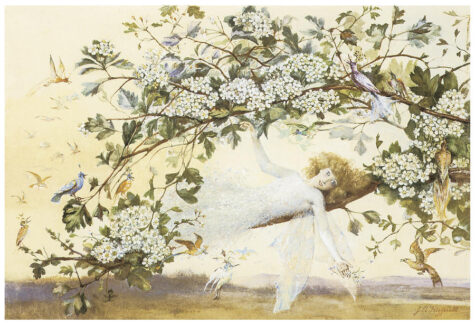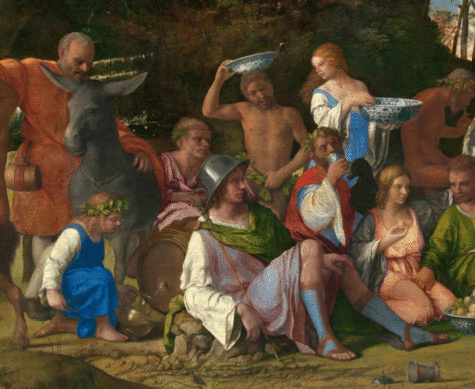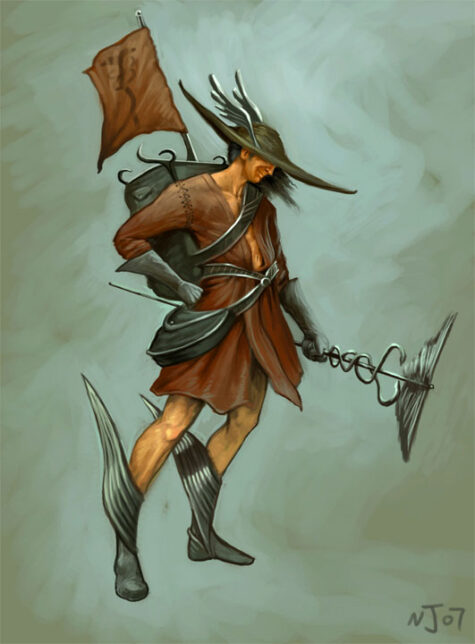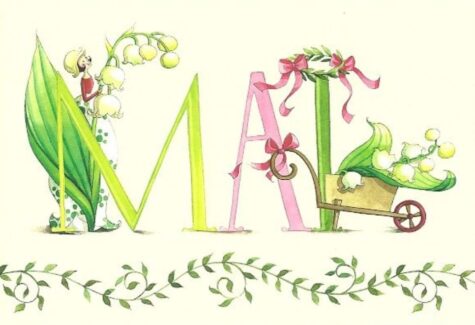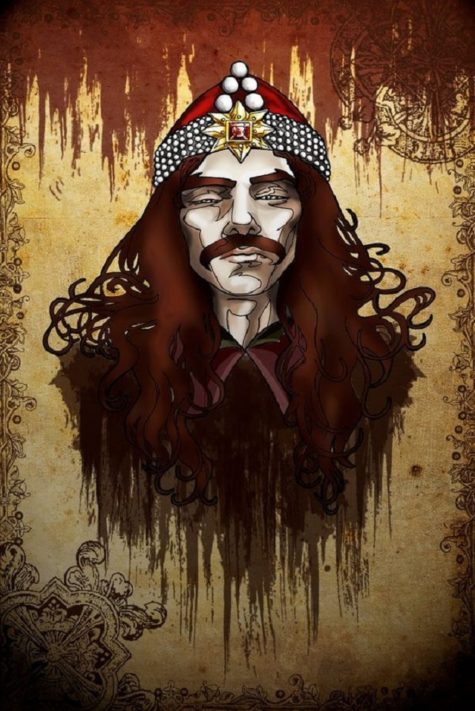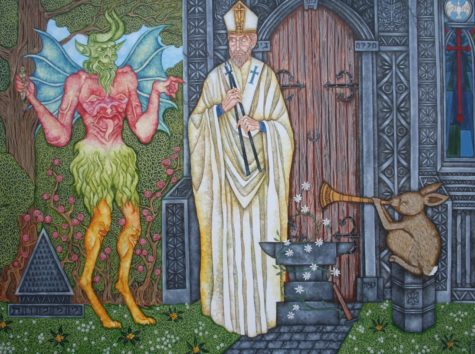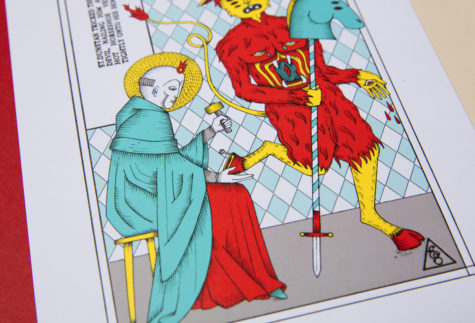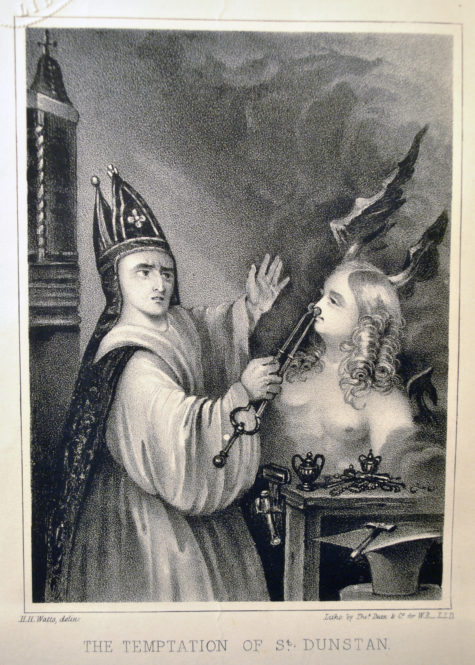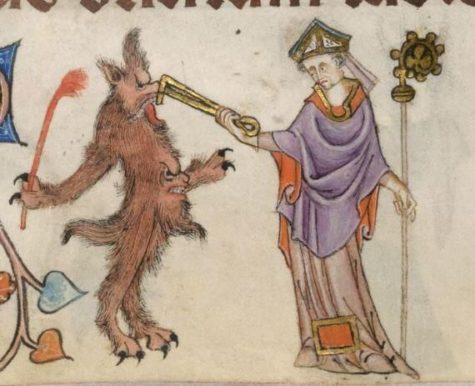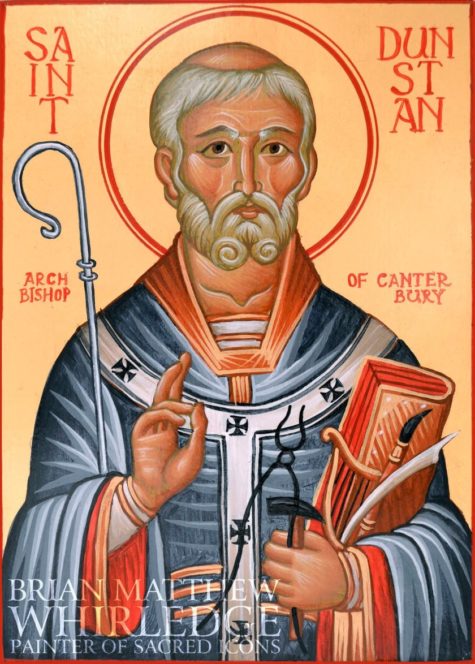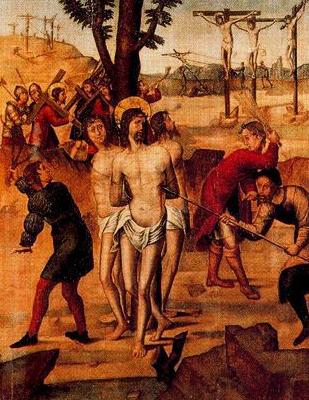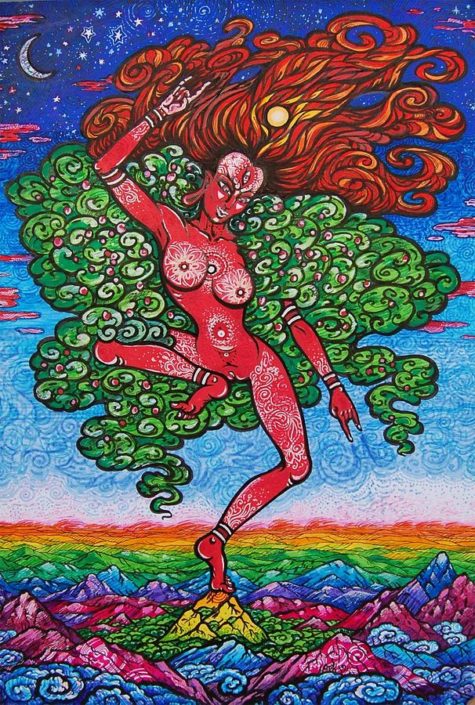May
The month of the Hawthorne is the time of fertility, masculinity, sexual energy, and fire. Coming right on the heels of Beltane, this month is a time when male potency is high — if you’re hoping to conceive a child, get busy this month!
The hawthorn is closely linked to witches due to an ancient belief that it was created from witches who had been transformed into trees. Any magic performed beside the hawthorn or during its month is though to be twice as powerful.
- Dates: May 13 – June 9
- Celtic Name: Huath,
- Language of Flowers: Hope
- Qualities: Healing, Protection, Passion, Commitment, Challenge
- Themes: Fertility, Masculine Energy, Fire, Business and Professional, Magical Protection
Take advantage of the fertile, prosperous energies of the month of the Hawthorn Moon to help you spice up your life.
This is the time for lovers to attend to matters of the heart, as the Celtic fire festival of Beltane heralds the start of summer. Celebrated on the first full Moon after the May tree (hawthorn) has blossomed, cattle were driven between two fires to purify them before moving to summer pastures. Young people were adorned with blossom and lovers lay in fields to empower their relationship and the crops with fertility and prosperity.
The Hawthorn has a raw, phallic sort of energy about it — use it for magic related to masculine power, business decisions, making professional connections. The Hawthorn is also associated with the realm of Faerie, and when the Hawthorn grows in tandem with an Ash and Oak, it is said to attract the Fae.
Adorned with flowers in spring, berries in autumn, and bare thorns in winter, the seasonal appearance of hawthorn has led to its sacred association with the three faces of the Great Goddess. Maiden (virginal white flowers of spring), Mother (rich, fertile red berries of autumn). And Crone (the cruel thorns of winter).
Hawthorn wood was traditionally used in amulets and charms. The wood grows into many twisted patterns, thought to be the origin of the love knot charm. As an amulet, the flowers were thought to ward off depression. The Romans placed such amulets in cradles to protect babies from curses.
Hawthorn the Illusionist
Just like Gemini in western astrology, the Hawthorn from the Celtic tree astrology isn’t all that it appears to be. Their exterior world can be completely different from the inner landscape and they can show a new side to you each day. If you hang out with Hawthorn signs too often, you’ll see that they put the term “never judge a book by its cover” to the test. They have a never-dying creative flame, always full of energy and curiosity.
This sign from the Celtic horoscope can adapt to any situation and can be both a good listener and give inspiring speeches. A good match for this shapeshifter can be the Ash or Rowan sign.
Magick and Lore
Hawthorn has a strong association with fertility, passion and love. When the Ancient Greek goddess Hera touched Hawthorn blossoms, she conceived twins.
Hawthorn seems to be particularly associated with wedding celebrations, perhaps because of its longtime reverence as the tree of that iconic May Day marriage of springtime that’s re-enacted in villages across Britain – the crowning of the May Queen, often bedecked in may blossom, and her joining together with the Oak King.
In Celtic writings, Cuchulainn calls hawthorn ‘most difficult night’ and Oengus calls hawthorn ‘whitening of the face’ – a moment when the face goes white at the thought of the challenges that lie before us.
Hawthorn has traditionally been seen as the tree of protection. As a hedgerow, it protects many little birds and animals, and up to 50 different species of insect. Hawthorn also protects boundaries – in Cornwall, clods of earth with a sprig of hawthorn were often left on boundary stones to protect the boundary of a farm or village area. Hawthorn hedges are still seen as powerful boundary protection for our modern homes, gardens and fields.
The ‘fairy trees’ or ‘faery thorns’ were respected and it was seen as very advisable never to harm a hawthorn, nor never to cut it except for ritual purposes when you would make a prayer and ask permission before taking any. Specifically, you should not clear hawthorn for practical purposes lest misfortune befall you!
Soulmate Attraction
Finding the right person to form a relationship with is not an easy task. Fortunately, you can harness the energetic forces of the Hawthorn to help you find that special someone.
Beside a hawthorn tree place a red candle in the earth and light it, saying,
“Trust by flowers white,
passion by berries red,
and protection of thorn.
May we grow together”.
Next describe your ideal partner on a red piece of paper. Bury it, allow the candle to burn. Decorate your door with Hawthorn blossoms, and you will find true love in the next summer.
Note: If you do not have the time to stay with the candle until it burns all the way down, bury what is left of it next to the paper. Do not leave a burning candle unattended next to a tree.
Sources:
Mercuralia is a Roman celebration known also as the “Festival of Mercury”. Mercury (Greek counterpart: Hermes) was the god of merchants and commerce. On May 15 merchants would sprinkle their heads, their ships and merchandise, and their businesses with water taken from the well at Porta Capena.
Some traditions celebrate the Mercuralia on May 4 because Mercury is the Roman incarnation of the Greek god Hermes. The sacred number of Hermes is four and it is said that his mother Maia gave birth to him on the fourth day of the month. The month of May is, of course, named after Maia.
About Mercury:
Mercury is a trickster spirit who is happy to masquerade as other spirits. Long ago the Italian deity Mercury was syncretized to Greek Hermes. The two are now virtually indistinguishable, but they are not the same spirit. Mercury is urban, while the roots of Hermes lie in the rustic countryside. Hermes has a a broader base of interests, while Mercury is a spirit of money, finances, and prosperity. His name is related to words like merchants, merchandise, or commerce as well as mercenary, a soldier of fortune.
Mercury is a generous spirit but his temperament is mercurial. He loves practical jokes and word games. Always be exceptionally careful how you phrase petitions to him, paying close attention to nuance and implication, lest he give you what you accidentally asked for, rather than what he knows very well that you desire.
Mercury has quicksilver intelligence and wit. He is easily bored. Keep him entertained and he’ll be more likely to keep you happy, healthy, and prosperous. Although Mercury patronizes the dishonest, he may also be invoked to protect against them.
Homeric Hymn to Hermes:
I sing about Hermes, the Cyllenian slayer of Argus, lord of Mt. Cyllene and Arcadia rich in flocks, the messenger of the gods and bringer of luck, whom Maia, the daughter of Atlas, bore, after uniting in love with Zeus.
She in her modesty shunned the company of the blessed gods and lived in a shadowy cave; here the son of Cronus used to make love to this nymph of the beautiful hair in the dark of night, without the knowledge of immortal gods and mortal humans, when sweet sleep held white-armed Hera fast.
But when the will of Zeus had been accomplished and her tenth month was fixed in the heavens, she brought forth to the light a child, and a remarkable thing was accomplished; for the child whom she bore was devious, winning in his cleverness, a robber, a driver of cattle, a guide of dreams, a spy in the night, a watcher at the door, who soon was about to manifest renowned deeds among the immortal gods.
Maia bore him on the fourth day of the month. He was born at dawn, by midday he was playing the lyre, and in the evening he stole the cattle of far-shooting Apollo.
So hail to you, son of Zeus and Maia. Hail, Hermes, guide and giver of grace and other good things.
Invocation to Hermes-Mercury-Tjehuti:
Hail to you, Hermes-Mercury-Tjehuti,
Fleet-footed Messenger of the Gods,
In all your many faces.
Come down from Mount Olympus,
Fly in from the mighty city of Roma,
Rise up from the land of Kemet,
Race across land and sea with your legendary speed,
And come join me this day!
As Hermes you are known as Argophontes,
The Psychopomp who guides souls to the Underworld,
Who, with your wand, bestows and banishes sleep and guides us through dreams,
You whose cleverness and oratory is unmatched,
With honeyed tongue and charm you ease your way through conflict,
Divine trickster extraordinaire,
Patron of learning and the sciences,
Patron of travelers on their journeys,
Of thieves and merchants,
Of wrestlers and magicians.
Ritual For The Mercuralia
The Greeks believed that the Egyptian god Tjehuti (Thoth) was also an incarnation/aspect of Hermes (or vice versa). This ritual honors the tri-form nature of this God by the name of Hermes-Mercury-Tjehuti.
I see Mercury as the most materially-oriented of the three aspects, focusing on business, commerce, and finances. I see Tjehuti as the most spiritually-oriented of the three aspects, focusing on wisdom, knowledge, abstract concepts, and the higher self. I see Hermes as a dynamic balance of the two, the aspect that binds them together.
For a ritual honoring and invoking Mercury, Hermes, and Tjehuti. You will need the following:
- Orange candle (representing Hermes)
- Yellow candle (representing Mercury)
- Purple candle (representing Tjehuti/Thoth)
- Fresh and dried peppermint (alternatively the candles can be anointed with peppermint essential oil)
- A dime with the head of Mercury on it (optional)
Set the mood by reading the Homeric Hymn to Hermes (above). Then invoke the Messenger of the Gods by reading aloud the Invocation to Hermes-Mercury-Tjehuti (above).
- Light the orange candle and say:
“As Mercury you rule communication and commerce.”
- Light the yellow candle and say:
“As Tjehuti you are the Voice of Ra,
Keeper of the Akashic Records and Karma,
Great one of truth, wisdom, and knowledge,
Great of Magick, Great of Healing.”
- Light the purple candle and say:
“Hermes-Mercury-Tjehuti,
I welcome you with an open mind and an open heart!”
Sprinkle dusted peppermint onto the candles and/or place freshly picked peppermint by the candles. If you have the dime, place it mercury side up next to the candles.
Spend time with the God’s presence and/or tell him of any financial, communicative, motivational, career, educational, or any other problem you’re having that is related to his many powers if you wish his help. Remember, his aid is less direct than many of the other deities’, for he is the God of cunning, guile, and oratory. Finally, close by saying:
Thank you for coming, blessed Hermes! Come and go in peace!
Extinguish the orange candle
Thank you for coming, blessed Mercury! Come and go in peace!
Extinguish the yellow candle
Thank you for coming, blessed Tjehuti! Come and go in peace!
Extinguish the purple candle
If you had freshly picked peppermint, leave it outside as an offering. Leave what is left of the extinguished candles at a busy crossroads. Leave the dime as an offering in a place where there might be merchants, magicians, travelers, jokesters or thieves.
Sources:
There is a lot to celebrate in May. This is a list of pretty much everything that goes on during the fifth month of the year. Many of these dates change from year to year. The days that change are marked with this » symbol.
May Lore and General Info

Astronomical Events
- 11 » New Moon
- 26 » Full moon – Hare’s Moon, Supermoon
- 26 » Total Lunar Eclipse
Astrological Events
Depending on which astrological system you adhere to, these are the signs that show up in May of 2021. Be aware that some of these dates will vary from year to year. Unlike the Sun signs which might just shift by 1 or 2 days, the dates of the various Moon signs will vary widely from year to year. The same holds true for the Chinese Zodiac. The Celtic Tree Signs are based on an arbitrary system and stay the same from year to year.
Western Astrology
The May Sun begins in Taurus and finishes up in Gemini:
- Apr 19 thru May 20 » Sun in Taurus
- May 20 thru Jun 21 » Sun in Gemini
The 2021 May Moon cycles through the signs as follows:
- Apr 30 – May 2 » Moon in Capricorn
- May 2 – May 5 » Moon in Aquarius
- May 5 – May 7 » Moon in Pisces
- May 7 – May 9 » Moon in Aries
- May 9 – May 12 » Moon in Taurus
- May 12 – May 15 » Moon in Gemini
- May 15 – May 27 » Moon in Cancer
- May 17 – May 19 » Moon in Leo
- May 19 – May 22 » Moon in Virgo
- May 22 – May 24 » Moon in Libra
- May 24 – May 26 » Moon in Scorpio
- May 26 – May 28 » Moon in Sagittarius
- May 28 – May 30 » Moon in Capricorn
- May 30 – Jun 1 » Moon in Aquarius
You will notice that the Moon might begin the day in one sign and by the end of the day may have moved into another sign, so timing matters if you are wanting to be precise.
The Celtic Tree Signs in May:
- Apr 15 to May 12 – Willow Tree Month
- May 13 to Jun 9 – Hawthorn Tree Month
The Alternative Celtic Zodiac is as follows:
- Poplar: May 1 – May 10
- Chestnut: May 11 – May 20
- Ash: May 21 – May 30
- Hornbeam: May 31 – Jun 10
The Chinese Calendar and Zodiac
We are currently in the year of the Ox (sometimes referred to as the Cow). Each Month is also assigned a specific animal. Here’s what shows up in May 2021.
- Dragon: Apr 4 – May 4 (Chinese Zodiac – Stem Branch Calendar)
- Dragon: Apr 12 – May 11 (Lunar Calendar – 3rd Lunar Month)
- Snake: May 5 – Jun 4 (Chinese Zodiac – Stem Branch Calendar)
- Snake: May 12 – Jun 9 (Lunar Calendar – 4th Month)
Note: The traditional Chinese Astrology birth chart is built by the Chinese Stem Branch Calendar, not the Chinese Lunar Calendar, which I think is really confusing. Because of a difference in time zones, the lunar months will have different pattern between China and the USA.
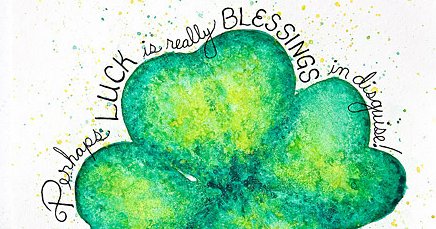
Lucky and Unlucky Days
You might want to plan moving, traveling, major purchases, court dates, and weddings around these dates, avoiding the unlucky days and utilizing the lucky ones.
- These are the lucky days in May:
3, 18, and 31. - These are the unlucky days in May:
7, 8, 17, 20, 27, 29 and 30.
Fatal Days
The third to slay poor man hath power.
The seventh destroyeth in an hour.
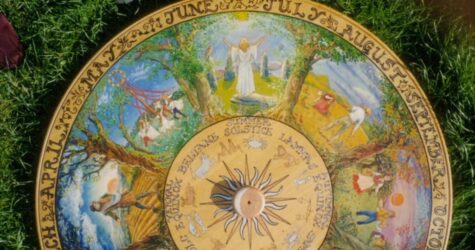
Holidays and Holy Days
Many of the holidays begin on the eve of the night before and end on the eve of the day of. It’s also important to remember that the dates of archaic festivals and feast days may vary widely depending on the source.
May 1
- 1: Mayday
- 1: Samhain (Southern Hemisphere)
- 1 » World Naked Gardening Day
- 1: Yom HaShoah – Jewish
- 1 thru 31: Flores de Mayo
May 2
- 2 » Humane Day
- 2: National Day of Prayer
- 2 » Los Mayos in Alhama de Murcia
May 3
- 3 to 4: Bona Dea
May 4
- 4: Midori no Hi – Greenery Day (Japan)
May 5
- 5: Cinco de Mayo
- 5: Kodomo-no-hi, Japan
- 5 thru 6: Kakava Spring Festival
May 6
- 6: Hidrellez – Spring Festival
- 6: Durdevan and the Feast of St. George
- 6 » Dakini Day (Tibetan)
May 7
- 7 » Day of Ekadashi (Hindu)
May 8
- 8: The Festival of Mens – the Roman goddess of mind and consciousness.
- 8: The Furry Dance
May 9
- 9 » Mother’s Day
- 9: A-ma Festival – Portugal and China, dates often vary
- 9 » Festival of Cats – held every 3rd year on the 2nd Sunday in May
- 9, 11, 13: Feast of the Lemures – see also Day of Remembrance
May 10
- 10 » Night of Hekate Suppers
- 10 and 31: Rosalia – Roman Memorial Day
May 11
- 11 thru 13: Icemen Days
May 12
- 12 » The Noumenia
- 12 thru 19: Ludi Cereales
May 13
- 13 » Celebrating The Agathos Daimon
- 13: Sacred Thorn Tree Day
- 13 » Eid al Fitr – Islam
- 13 » Ascension Day
May 14
May 15
- 15: Festival of Mercury – the Roman god of merchants and travelers
- 15: Cold Sophie
May 18
May 19
- 19: Visakha Puja – Buddha Day
- 19 thru 28: Festival of Kallyntaria and Plynteria
May 20
May 21
- 21 thru 23: The Anastenaria
May 23
- 23: World Turtle Day
- 23: The Tubilustrium
- 23 » Day of Ekadashi (Hindu)
- 23 » Pentecost – Whit Sunday
- 23 or 24: Declaration of the Bab
May 24
- 24 » Whit Monday
- 24 » Victoria Day
- 24: The Thargalia
- 24, 25: Festival of the Holy Marys – Gypsy festival and pilgrimage
- 24 thru 28: Mothers of Arles
May 25
- 25: Celebration of the Tao – The Mother of the World
May 26
May 27
- 27: Frigga Blot
May 28
- 28: Einherjar Day
- 28: Insect Hearing Festival
May 29
- 29: The Ambarvalia
- 29: Oak Apple Day
May 30
May 31
- 31 » Memorial Day
- 31: Flores de Mayo ends with the Santacruzan Procession

Saint Days
There is a surprising amount of magick associated with Saint days. This is a very short list of the Saint days in May, there are many many more. As time goes by I may end up listing them all, but for now, this is what I have.
- 3: Feast day of Saint Philip
- 3: Feast day of Saint James
- 6: Feast of St. George
- 7: St Agathius Day (sometimes listed as May 8)
- 19: St Dunstan’s Day

Recipes For May
- May Wine – May Day, and The Floralia
- May Serpent Cake – May Day
- May Day Maple Hearth Bread – May Day
- Elderflower Fritters – Beltane, May Day, and The Floralia
- Farls – For Beltane – Beltane
- Simnel Cake – Easter, Ostara,the Vernal Equinox, and Mother’s Day
Many more seasonal recipes, including recipes for new and full moon ceremonies, ancient Greek and Roman holidays, Asian festivals and etc can be found here: Seasonal Recipes.
![]()
Notes:
Any May lore, almanac, astrological, and celebration dates that have been shared after this post was published can be found by searching the May posts to see what’s new.
A lot of work went into this post. It was compiled from various sources by Shirley Twofeathers for The Pagan Calendar, you may repost and share without karmic repercussions, but only if you give me credit and a link back to this website. Blessed be.
During the time of April showers, the watery month of the Willow Moon teaches you to release pent-up emotions and experience your grief. Tears are linked to healing and as you express difficult and painful feelings, you are able to purge yourself of subconscious fears, which would otherwise prevent you from reaching your dreams.
The Willow Moon offered a healing month to the Celts who literally spring-cleaned themselves in steamy saunas, known as sweat lodges, in readiness for the Beltane Festival at the start of May.
- Dates: April 15 – May 12
- Celtic Name: Saille
- Color: Silver
- Themes: Healing, growth, protection, women, nurturing.
- Language of Flowers: Mourning
- Qualities: Healing, Flexibility, Grace, Compassion
This month is the month for spells and rituals for growth, healing, nurturing, and magick related to the mystery of women. It is also associated with fertility, inspiration, protection, binding, and creativity. The willow tree was sacred to Crone aspect of the triple goddess in Celtic lore, and closely associated with the Cailleach (“old woman” in Gaelic).
The Willow Moon provides the perfect time to harness lunar power and energy for wishing, divination, healing, and protection.
Linked with the energy of the moon, the willow takes on a feminine-type energy of flow, flexibility and balance as well as gentle compassion and emotional sensitivity.
This month is the perfect time to perform lunar magic and to let go of the past. Cast energy to restore and nurture during the Waxing Moon and to release problems during the Waning Moon. Drinking more water will also help you to attune to the Willow Moon, and so enable you to connect to the tree’s watery magic.
Because the Willow is imbued with the power of the Moon, it has always been particularly linked with witchcraft. The traditional witches’ broom is bound with a Willow branch and lunar wands used specifically for Moon magic are made of Willow wood.
The Willow’s close ties to the Moon and tides also connects it to affairs of the heart. An old English tradition involved jilted lovers wearing a sprig of Willow in their hats, which originated from an ancient Willow charm to heal a broken heart.
Willow the Observer
According to the Celtic horoscope, people born under the sign of the Willow hold many aspects of the lunar realm. They tend to be highly creative and intuitive and often possess higher IQ. Willow signs understand cycles and know very well that everything that happens in your life can teach you a lesson. This Celtic tree astrology sign is patient and down to earth. Ivy and Birch signs can be a good match for the Willow sign.
Willow people have a lot of imagination, sometimes they like to daydream and they are able to understand exactly how other people feel. They are very good psychologists and they can use this ability for their advantage.
People born under the rule of Willow can enjoy life to the fullest; they know exactly what they need in their life and where to find it. From time to time these people become restless without reason and this restlessness forces them to change jobs, frequently move from one place to another and to make various other changes in their lives.
Despite their instability, they are very honest and principled under any circumstances. They literally shock others with courageous and honest acts that do not benefit them. Their adaptability and tolerance allows them to eat at one table with beggars or kings without having to pretend anything.
Willow people usually live a long life and they become respected elders. When they get old, the settle down and because of their rich life full of changes they become a rich source of inspiration for other people.
Willow Magick and Lore
Willows are often seen as gateway or boundary trees – the trees of the ‘in-between’ liminal places – on the banks of rivers and streams, between water and dry land. In ancient Celtic times, watery places were seen as sacred places – so willow trees were viewed as able to connect the world of humans with the mystical Otherworld.
Bees are very attracted to all kinds of willow trees for the pollen and were seen as messengers from the Otherworld.
In ancient Tibet, the willow was revered as the ‘world tree’ or ‘tree of life’. Because of its healing use by the wise women, the willow became known as the ‘witch’s tree’ and later as ‘witch’s aspirin’.
The willow is often linked to the Celtic ‘Morrigan’ or Morgana le Fay of Arthurian legend.
As well as healing, willow traditionally protects. Goat willow (Pussy willow) was known as Palm Willow and was commonly cut for Palm Sunday celebrations and carried to church. The Palm Willow was then kept through the year to protect the home against thunder, lightning, disease and other dangers.
Willow twigs would be placed around the hearth of the home and around crops or animals in garden and fields to protect these for the coming year. It is thought that the ancient Celtic Druids would use goat willow to make wands to give protection against evil.
The saying “knock on wood” or “touch wood” may have come from ancient customs of knocking on or touching a willow tree to bring good fortune and avoid bad fortune.
The Celts would use willow wood for coracles and boats and travelers and adventurers would set out with the protection of being in willow boats ‘over the ninth wave’ to seek their destiny.
Druids would sleep beneath willow trees to involve dreams of divination and Celtic priests would use cut willow for the same purpose. In Celtic tales of Manannan mac Lir, willow rods were used for divination.
Willows grow vigorously in spring and even a small twig or cut branch of willow, stuck into the ground, will quickly take root and grow into a young sapling. As such, the willow is seen to represent rebirth, new life, and vigor – including fertility. In fact, ancient Chinese tradition sees the willow as a tree of immortality for this very special ability.
Willow Moon Ritual
This Willow tree ritual should be performed outside and can be used to make a wish. or heart’s desire, come true.
At the time of the full Moon go to a shallow river or stream where willow trees grow. Stand with your feet in the water and hold your arms up towards the Moon. Visualize moonlight flooding your aura, filling your body with each breath. Recite this incantation:
“Lady Moon of wax and wane,
bring my wish and take my pain”
Perform an act of ritual purification by washing your hands in the water by the roots of the tree, Focus on your wish and tie a knot with string around a willow branch to seal it. When your wish comes true, untie the knot.
Sources:
May 26 is World Dracula Day which commemorates Bram Stoker’s Gothic horror novel Dracula, which was first published on May 26 in 1897, by Archibald Constable and Company in Britain. It sold for six shillings and came bound in yellow cloth with red lettering. It was first printed in the United States two years later, by Doubleday & McClure of New York City. Although not the first novel about vampires, it became a model for the genre, and laid the foundation for future vampire stories, with its introduction of the character Count Dracula.
The quintessential vampire, Count Dracula has inspired tens of films and stories the world over, not to mention the virtual immortality of the character during as a beloved Halloween character. For all of these reasons, it’s undeniable that this icon of horror more than deserves his own little holiday so the world can show its appreciation for his contributions to the worlds of cinema and literature over the centuries. So put on your fangs, and let’s sink out teeth right into this, shall we?
About The Book
The book follows (spoiler alert!) an English lawyer named Jonathan Harker as he travels to Transylvania to meet Count Dracula at his castle, Castle Dracula. To Harker, Dracula appears pale and off-kilter. The strangeness of Dracula is more apparent after he lunges at Harker’s throat after Harker cuts himself while shaving. Harker eventually finds out that Dracula is a vampire who needs to drink human blood to survive. Afterward, Dracula locks Harker in the castle and flees to England with 50 boxes of dirt (it is believed he needs dirt from his home country to stay healthy). As Dracula heads to England to search for new blood, Harker eventually escapes from the castle.
Meanwhile, Mina, Harker’s fiancée, is visiting her friend Lucy in England. One night, Mina finds Lucy sleepwalking by a graveyard. Mina believes she sees a creature hovering over Lucy for a moment, and then notices two red marks on Lucy’s neck. Lucy becomes sick over the next few days and is then cared for by a Dr. Seward and by Dr. Abraham Van Helsing, before eventually dying. Afterward, strange reports begin surfacing that a creature has been attacking children in the area.
Jonathan Harker and Mina are reunited and married. Harker tells Dr. Helsing about his experience with Dracula, and Helsing then believes Lucy contracted vampirism from him and is the one attacking children. They dig up her corpse, cut off her head, put a stake through her heart, and stuff her mouth with garlic. They then turn their focus to Dracula and try to destroy his boxes of dirt. He escapes back to Transylvania, where they find him buried in the last box of dirt. They cut off his head and stab him through the heart, causing him to collapse into dust.
The Origins Of Dracula
Stoker spent years researching vampires before writing Dracula. During that time, he was particularly influenced by “Transylvanian Superstitions,” an essay by Emily Gerard that was published in 1885. Stoker worked at the Lyceum Theatre in London from 1878 to 1898. The theater was headed by Henry Irving, who Stoker based Dracula’s mannerisms on. It was even Stoker’s hope that Irving would play Dracula in a stage adaptation, but it did not happen.
According to one theory, Prince Vlad III of Wallachia (Romania) was the real-life inspiration behind Stoker’s gothic horror novel. An extremely cruel and merciless ruler, Vlad earned the nickname “Vlad the Impaler” for the many ways he tortured his opponents as well as people who betrayed him when they were captured. As can be guessed from his nickname, impaling was his favorite method of execution, and it is thought that he killed up to 100,000 people during his reign, and was infamous for the “forests” of impaled victims he left behind when he won a battle. One unsubstantiated account says that he dipped bread in his victims’ blood and ate it in front of them as they died on stakes.
Born in Transylvania in the fifteenth century, he was also called Drăculea, which means “Son of Dracul.” Indeed, his father was known as Dracul, a name that derived from the knightly order he belonged to—the Order of the Dragon (the Latin word draco means dragon). In modern Romanian, drac means “devil.”
It is believed that Stoker picked the name Dracula after learning this more modern translation. Some believe that the only connection between Vlad III and Dracula are their names. The connection of his character with vampirism was made by Bram Stoker around the 1890’s, and has become a permanent element of pop culture since then.
What does it mean?
Dracula has been interpreted in numerous ways. Some have interpreted the story as an allegory of the fear that western Europeans had of eastern Europeans coming into their area. Hence, the story of someone coming from Transylvania—in Romania—to London and wreaking havoc on its residents. This theme appeared in other novels of the time.
Some have seen the book as a reaction to the conservative and patriarchal norms of the Victorian period, and as an exploration of suppressed sexual desire. Some also have seen the book as being about the relationship between the past and future, with Dracula symbolizing a primitive past that challenges modernity.
The Historical Vampire
The concept of vampirism dates back thousands of years. The ancient Greeks, Hebrews, Egyptians and Babylonians all had legends telling hair-raising tales of demon-like undead creatures that lived off of the blood of the living.
Tales of the undead consuming the blood or flesh of living beings have been found in nearly every culture around the world for many centuries. Today we know these entities predominantly as vampires, but in ancient times, the term vampire did not exist; blood drinking and similar activities were attributed to demons or spirits who would eat flesh and drink blood; even the devil was considered synonymous with the vampire.
Almost every nation has associated blood drinking with some kind of revenant or demon, from the ghouls of Arabia to the goddess Sekhmet of Egypt. Indeed, some of these legends could have given rise to the European folklore, though they are not strictly considered vampires by historians when using today’s definitions.
Hebrews, ancient Greeks, and Romans had tales of demonic entities and blood-drinking spirits which are considered precursors to modern vampires. Despite the occurrence of vampire-like creatures in these ancient civilizations, the folklore for the entity we know today as the vampire originates almost exclusively from early 18th-century Southeastern Europe, particularly Transylvania as verbal traditions of many ethnic groups of the region were recorded and published. In most cases, vampires are revenants of evil beings, suicide victims, or witches, but can also be created by a malevolent spirit possessing a corpse or by being bitten by a vampire itself. Belief in such legends became so rife that in some areas it caused mass hysteria and even public executions of people believed to be vampires.
In India, tales of vetalas, ghoul-like beings that inhabit corpses, are found in old Sanskrit folklore. Although most vetala legends have been compiled in the Baital Pachisi, a prominent story in the Kathasaritsagara tells of King Vikramāditya and his nightly quests to capture an elusive one. The vetala is described as an undead creature who, like the bat associated with modern-day vampirism, hangs upside down on trees found on cremation grounds and cemeteries. Pishacha, the returned spirits of evil-doers or those who died insane, also bear vampiric attributes.
The Hebrew word “Alukah” (literal translation is “leech”) is synonymous with vampirism or vampires, as is “Motetz Dam” (literally, “blood sucker”). Later vampire traditions appear among diaspora Jews in Central Europe, in particular the medieval interpretation of Lilith. In common with vampires, this version of Lilith was held to be able to transform herself into an animal, usually a cat, and charm her victims into believing that she is benevolent or irresistible. However, she and her daughters usually strangle rather than drain victims, and in the Kabbalah, she retains many attributes found in vampires.
A late 17th- or early 18th-century Kabbalah document was found in one of the Ritman library’s copies of Jean de Pauly’s translation of the Zohar. The text contains two amulets, one for male (lazakhar), the other for female (lanekevah). The invocations on the amulets mention Adam, Eve, and Lilith, Chavah Rishonah and the angels—Sanoy, Sansinoy, Smangeluf, Shmari’el, and Hasdi’el. A few lines in Yiddish are shown as dialog between the prophet Elijah and Lilith, in which she has come with a host of demons to kill the mother, take her newborn and “to drink her blood, suck her bones and eat her flesh”. She informs Elijah that she will lose power if someone uses her secret names, which she reveals at the end.
Other Jewish stories depict vampires in a more traditional way. In “The Kiss of Death”, the daughter of the demon king Ashmodai snatches the breath of a man who has betrayed her, strongly reminiscent of a fatal kiss of a vampire. A rare story found in Sefer Hasidim #1465 tells of an old vampire named Astryiah who uses her hair to drain the blood from her victims. A similar tale from the same book describes staking a witch through the heart to ensure she does not come back from the dead to haunt her enemies.
More about Vampires can be found at The Powers That Be.
How to celebrate Dracula Day
Celebrating all things Dracula why not throw a party and get your friends round for the ultimate film binge. Ideas for creating the perfect atmosphere include giving your party a Gothic feel by making sure all of your decorations are either black or blood red, the table setting is rather sophisticated, everyone is dressed elegantly and wears fangs, hanging up plenty of bat and spider web decorations, and serving plenty of blood red drinks.
It would also be perfect to watch one or more of the classic vampire movies to have been made, such as the 1958 British classic titled simply “Dracula”, and starring the incredibly impressive Christopher Lee as the aristocratic titular character. Other movie choices include “Nosferatu”, a 1922 German expressionist horror film, and “Interview with the Vampire” starring Tom Cruise, Brad Pitt, and a young Kirsten Dunst.
If it’s something more lighthearted you’re looking for, Roman Polański’s “The Fearless Vampire Killers, or Pardon Me, But Your Teeth Are in My Neck” will keep everyone entertained. Lesser known, but equally fun movies include Suck (one of my personal favorites), and Jesus Christ Vampire Hunter.
If you don’t plan on hosting a party, that does not mean you have to miss out on Dracula day—take the time to delve into the world created by Bran Stoker in his acclaimed novel. Reading a good book has never hurt anyone, and in the era social media’s 140-character blurbs of text, it is ever more important to keep the art of literature alive.
If you’ve already read it, consider tackling Anne Rice’s “Vampire Chronicles”, a series of 11 critically acclaimed books that follow influential vampires all throughout history. Stephen King’s “Salem’s Lot”. As you can see, there is no shortage of ways to celebrate the vampires of the world this Dracula Day!
Vampire Magick:
If you get really excited about all this talk of vampires, blood, and the undead, you might even be interested in exploring spells to “become a vampire.” Alternatively, you might want to play around with some protection against vampires spells, vampire prevention spells, or even a peaceful coexistence spell. They can all be found in the Book of Shadows, and Gypsy Magick and Lore.
Sources:
Traditional weather lore has it that St. Dunstan was a great brewer who sold himself to the devil on the condition that the devil would blight the apple trees to stop the production of cider, Dunstan’s rival drink. This is said to be the cause of the wintry blast that usually comes about this time. (May 19)
Foggier yet, and colder! Piercing, searching, biting cold. If the good Saint Dunstan had but nipped the Evil Spirit’s nose with a touch of such weather as that, instead of using his familiar weapons, then, indeed, he would have roared to lusty purpose.
~A Christmas Carol
This piece of folklore seeks to explain the late May frosts, known as ‘Franklin Days’ in the West Country, which often hit between 17-19 or 19-21 May. The tale was apparently particularly popular in Devon in the 19th and 20th centuries and goes thus:
Dunstan had bought some barley and made some beer, which he then hoped to sell for a good price. Seeing this the Devil appeared before him and offered to blight the local apple trees with frost (the tale is presumably set in Somerset, perhaps when Dunstan is Abbot of Glastonbury). This would ensure there was no cider and so drive demand for beer. Dunstan accepted the offer but stipulated that the frost should strike from the 17-19 May.
Stories About St. Dustan and the Devil:
According to legend, St. Dunstan had a number of encounters with the devil. The most famous story, which entered popular folklore, tells how he pulled the devil by the nose with his blacksmith’s tongs.
The story goes that while he was living as a hermit in a cell at Glastonbury, he occupied himself with various crafts, including metalwork. Against the old church of St Mary he built a small cell five feet long and two and a half feet deep. It was there that Dunstan studied, worked at his handicrafts, and played on his harp. It is at this time, according to a late 11th-century legend, that the Devil is said to have tempted Dunstan.
One day, as evening was coming on, an old man appeared at his window and asked him to make a chalice for him. Setting aside what he was working on, Dunstan agreed to the request and set to work. But as he was working his visitor began to change shape: one moment he was an old man, then a young boy, then a seductive woman.
Dunstan realized that his guest was the devil; but, pretending not to notice, he went on with his task. He took up the tongs from among his tools and laid them in the fire, waiting until they were red-hot. Then, pulling them out of the fire, he turned round and seized the devil by the nose with the tongs. The devil struggled and screamed, but Dunstan held on until at last he felt he had triumphed. Then he threw the devil out of his cell and it fled, running down the street and crying “Woe is me! What has that bald devil done to me? Look at me, a poor wretch, look how he has tortured me!”
St Dunstan stood in his ivied Tower,
Alembic, crucible, all were there;
When in came Nick to play him a trick,
In guise of a damsel passing fair.
Every one knows
How the story goes:
He took up the tongs and caught hold of his nose.
~Lay of St Dunstan, 1840
Many people heard and saw this, and the following day they came to Dunstan and asked him what had happened. He said to them, “These are the tricks of devils, who try to trap us with their snares whenever they can. But if we remain firm in the service of Christ, we can easily defeat them with his help, and they will flee from us in confusion.” And from that time he dwelt safely in his little cell.
The story was of course retold in other forms, as here in playful fashion in the South English Legendary:
þe deuel he hente bi þe nose & wel faste drou;
He twengde & ssok hure bi þe nose þat þe fur out blaste.
þe deuel wrickede here & þere & he huld euere faste,
He 3al & hupte & drou a3en & made grislich bere.
He nolde for al is bi3ete þat he hadde icome þere!
Wiþ is tonge he strok is nose & twengde him euere sore,
Forte it was wiþinne ni3te þat he ne mi3te iseo namore.
þe ssrewe was glad & bliþe inou þo he was out of is honde
And flei & gradde bi þe lift þat me hurde into al þe londe:
“Out, wat haþ þis calwe ido? wat haþ þis calwe ido?”
In þe contreie me hurde wide hou þe ssrewe gradde so.
As god þe ssrewe hadde ibeo habbe ysnut atom is nose,
He ne hi3ede namore þuderward to tilie him of þe pose.
He seized the devil by the nose and pulled very hard; he tweaked and shook him by the nose so that fire burst out. The devil wriggled here and there, and he still held fast. He yelled and hopped and pulled away and made a horrible commotion. He wished for all the world that he’d never come there! With his tongs Dunstan yanked at his nose and nipped him very sore, until night came on and he could no longer see. The villain was glad and happy indeed that he was out of his hands, and fled and cried out so it was heard all over the land: “Alas, what’s this bald one done? What’s this bald one done?” It was heard far around how the wicked one cried out. The villain had got such a good tweaking of his nose, he never hurried back there again to heal his cold!
On another occasion, when Dunstan was praying alone, the devil appeared to him in the likeness of a wolf with a gaping mouth, snarling and baring his teeth. Dunstan would not be distracted from concentration on his prayers, so the devil suddenly changed himself into a little fox, trying to get Dunstan’s attention by jumping about, contorting himself and trying to get Dunstan to laugh at him.
But, smiling a little, Dunstan only said, “You are revealing how you usually behave: by your tricks you flatter the unwary so that you can devour them. Now get out of here, wretch, since Christ, who crushed the lion and the dragon with his heel, will overcome you by his grace through me, whether you’re a wolf or a fox.”
Another legend regarding the Devil and St. Dunstan also occurred in Mayfield when the convent there had just been built. The Devil appeared to St. Dunstan and said that he was going to knock down all the houses in the village. St. Dunstan bargained with the Devil and got him to agree to leave standing any house with a horseshoe on the outside. At that time, the custom of nailing horseshoes to doors for luck wasn’t well known so the Devil agreed but St. Dunstan managed to nail a horseshoe to all the houses in the village before the Devil could get to them so the village was saved.
The Devil managed to get some measure of revenge against St. Dunstan by repeatedly setting Mayfield church, then built of wood, off its normal East-West axis, leaving St. Dunstan to repeatedly correct it. According to the lore, this was accoplished by pushing the church back into the proper east-west alignment with his shoulder!
Another church is involved with yet another St. Dunstan story. This time it is the steeple of the church in the village of Brookland, just over the border into Kent. The Devil took the steeple and was chased by St. Dunstan who caused the Devil to drop the steeple near Hastings by application of the tongs mentioned in the Mayfield story.
According to one version of the story, the injured devil flew off from Mayfield to cool his nose in the springs of Tunbridge Wells, and that’s how its famous waters got their reddish tint (don’t let anyone tell you it’s because of the iron in the water). Alternatively, he flew away with the tongs still attached to his nose, and they dropped off in the place near Brighton which is now called Tongdean (for, I hope, obvious reasons).
About Saint Dustan:
- Feastday: May 19
- Patron of armorers, goldsmiths, locksmiths, and jewelers
Born of a noble family at Baltonsborough, near Glastonbury, England, Dunstan was educated there by Irish monks and while still a youth, was sent to the court of King Athelstan. He became a Benedictine monk about 934 and was ordained by his uncle, St. Alphege, Bishop of Winchester, about 939.
After a time as a hermit at Glastonbury, Dunstan was recalled to the royal court by King Edmund, who appointed him abbot of Glastonbury Abbey in 943. He developed the Abbey into a great center of learning while revitalizing other monasteries in the area. He became advisor to King Edred on his accession to the throne when Edmund was murdered, and began a far-reaching reform of all the monasteries in Edred’s realm.
Dunstan also became deeply involved in secular politics and incurred the enmity of the West Saxon nobles for denouncing their immorality and for urging peace with the Danes. When Edwy succeeded his uncle Edred as king in 955, he became Dunstan’s bitter enemy for the Abbot’s strong censure of his scandalous lifestyle. Edwy confiscated his property and banished him from his kingdom.
Dunstan went to Ghent in Flanders but soon returned when a rebellion replaced Edwy with his brother Edgar, who appointed Dunstan Bishop of Worcester and London in 957. When Edwy died in 959, the civil strife ended and the country was reunited under Edgar, who appointed Dunstan Archbishop of Canterbury. The king and archbishop then planned a thorough reform of Church and state.
Dunstan was appointed legate by Pope John XII, and with St. Ethelwold and St. Oswald, restored ecclesiastical discipline, rebuilt many of the monasteries destroyed by the Danish invaders, replaced inept secular priests with monks, and enforced the widespread reforms they put into effect. Dunstan served as Edgar’s chief advisor for sixteen years and did not hesitate to reprimand him when he thought it deserved.
When Edgar died, Dunstan helped elect Edward the martyr king and then his half brother Ethelred, when Edward died soon after his election. Under Ethelred, Dunstan’s influence began to wane and he retired from politics to Canterbury to teach at the Cathedral school and died there. Dunstan has been called the reviver of monasticism in England. He was a noted musician, played the harp, composed several hymns, notably Kyrie Rex splendens, was a skilled metal worker, and illuminated manuscripts.
Sources:
The feast day of St Agathius is May the 7th, (formerly May 8th). It is unclear why the date was changed, and some information online still has it listed as May the 8th. He is a patron saint of soldiers, and most often invoked against headaches.
- About him:
Saint Agathius (Greek: Ακακιος; died 303), also known as Achatius or Agathonas or Acacius of Byzantium, according to Christian tradition, was a Cappadocian Greek centurion of the imperial army, martyred around 304.
Agathius was arrested on charges for being a Christian by Tribune Firmus in Perinthus, Thrace, tortured and then brought to Byzantium where he was scourged and beheaded, being made a martyr because he would not renounce his Christian faith. The date of his martyrdom is traditionally May 8, when his feast is observed.
- Note:
St. Acacius the Centurion is not to be confused with the St. Acacius who was crucified in the second century along with 10,000 (!) companions. Neither of these martyrs is the St. Achatius numbered among the “14 Holy Helpers.”
- For Headaches:
I’ve found that amethyst is one of the best gemstones to help relieve headaches and reduce stress and tension. You can simply sit quietly and hold a piece of amethyst against your forehead, or you could make a gem elixir so that you can take a drop or two of the liquid when necessary.
Another traditional spell is to find a pebble and hold it against your head and say: ‘Pain from my head go into this stone, go into this stone, go into this stone. Pain from my head go into this stone, go into this stone and stay there.’ Then take the stone outside and hurl it away from you with as much force as you can manage.
Sources:
According to astrological and lunar lore, there are best days for doing a variety of tasks. The best days listed here are based on both the phase of the moon and its position in the zodiac. Many people believe that if you do the tasks on the dates listed, you will get the best results possible.
May 1:
- Cut Hair (to slow growth)
- Demolition
- Harvest
- Kill Plant Pests
- Mow Grass (to slow growth)
- Pick Apples and Pears
- Quit Smoking
- Start Diet (to lose weight)
- Wash Wooden Floors
May 2:
- Cut Hair (to slow growth)
- Demolition
- Harvest
- Kill Plant Pests
- Mow Grass (to slow growth)
- Pick Apples and Pears
- Quit Smoking
- Start Diet (to lose weight)
- Wash Wooden Floors
May 3:
- Advertise Something for Sale
- Ask For a Loan
- Dig Post Holes
- Get Married
- Make Jams and Jellies
- Mow Grass (to slow growth)
- Paint
- Plant Root Crops
- Transplant (seedlings and plants)
May 4:
- Advertise Something for Sale
- Buy a Home
- Cut Firewood
- Cut Hair (to increase growth)
- Dig Holes
- Get Married
- Mow Grass (to increase growth)
- Paint
- Plant Above Ground Crops
- Wax Floors
May 5:
- Cut Firewood
- Dig Holes
- Kill Plant Pests
- Mow Grass (to increase growth)
- Travel (for pleasure)
May 6:
- Cut Firewood
- Dig Holes
- Kill Plant Pests
- Mow Grass (to increase growth)
- Travel (for pleasure)
May 7:
- Cut Firewood
- Dig Holes
- Kill Plant Pests
- Mow Grass (to increase growth)
- Travel (for pleasure)
May 8:
- Bake
- Buy a Home
- Cut Firewood
- Cut Hair (to increase growth)
- Dig Holes
- Get Married
- Mow Grass (to increase growth)
- Plant Above Ground Crops
- Plant Flowers
- Plant Seed Beds
- Start Diet (to gain weight)
- Wax Floors
May 9:
- Bake
- Buy a Home
- Cut Firewood
- Cut Hair (to increase growth)
- Dig Holes
- Get Married
- Mow Grass (to increase growth)
- Plant Above Ground Crops
- Plant Flowers
- Plant Seed Beds
- Start Diet (to gain weight)
- Wax Floors
May 10:
- Buy a Home
- Cut Firewood
- Dig Holes
- Get Married
- Kill Plant Pests
- Mow Grass (to increase growth)
- Paint
- Travel (for pleasure)
May 11:
- Cut Firewood
- Dig Holes
- Get Married :
- Kill Plant Pests
- Mow Grass (to increase growth)
- Paint
- Travel (for pleasure)
May 12:
- Cut Firewood
- Dig Holes
- Kill Plant Pests
- Mow Grass (to increase growth)
- Wax Floors
May 13:
- Cut Firewood
- Dig Holes
- Kill Plant Pests
- Mow Grass (to increase growth)
- Wax Floors
May 14:
- Bake
- Cut Firewood
- Dig Holes
- Get Married
- Mow Grass (to increase growth)
- Plant Above Ground Crops
- Plant Flowers
- Wax Floors
May 15:
- Bake
- Cut Firewood
- Dig Holes
- Get Married
- Mow Grass (to increase growth)
- Plant Above Ground Crops
- Plant Flowers
- Set Eggs
- Wax Floors
May 16:
- Cut Firewood
- Cut Hair (to increase growth)
- Dig Holes
- Mow Grass (to increase growth)
- Plant Above Ground Crops
- Plant Seed Beds
- Set Eggs
- Wax Floors
May 17:
- Cut Firewood
- Cut Hair (to increase growth)
- Dig Holes
- Mow Grass (to increase growth)
- Plant Above Ground Crops
- Plant Seed Beds
- Wax Floors
May 18:
- Advertise Something for Sale
- Castrate Farm Animals
- Cut Hair (to slow growth)
- Demolition
- Dry Fruits and Vegetables
- Kill Plant Pests
- Mow Grass (to slow growth)
- Pick Apples and Pears
- Potty Train a Child
- Quit Smoking
- Slaughter
- Start Diet (to lose weight)
- Wash Windows
- Wash Wooden Floors
- Wean a Baby or an Animal
May 19:
- Advertise Something for Sale
- Castrate Farm Animals
- Cut Hair (to slow growth)
- Demolition
- Dry Fruits and Vegetables
- Kill Plant Pests
- Mow Grass (to slow growth)
- Pick Apples and Pears
- Potty Train a Child
- Quit Smoking
- Slaughter
- Start Diet (to lose weight)
- Wash Windows
- Wash Wooden Floors
- Wean a Baby or an Animal
May 20:
- Advertise Something for Sale
- Castrate Farm Animals
- Cut Hair (to slow growth)
- Demolition
- Dry Fruits and Vegetables
- Kill Plant Pests
- Mow Grass (to slow growth)
- Pick Apples and Pears
- Potty Train a Child
- Quit Smoking
- Slaughter
- Start Diet (to lose weight)
- Wash Windows
- Wash Wooden Floors
- Wean a Baby or an Animal
May 21:
- Castrate Farm Animals
- Mow Grass (to slow growth)
- Plant Root Crops
- Potty Train a Child
- Prune Trees
- Wean a Baby or an Animal
May 22:
- Castrate Farm Animals
- Mow Grass (to slow growth)
- Plant Root Crops
- Potty Train a Child
- Prune Trees
- Wean a Baby or an Animal
May 23:
- Castrate Farm Animals
- Cut Hair (to slow growth)
- Dig Post Holes
- Kill Plant Pests
- Make Jams and Jellies
- Mow Grass (to slow growth)
- Paint
- Potty Train a Child
- Quit Smoking
- Start Diet (to lose weight)
- Wash Wooden Floors
- Wean a Baby or an Animal
May 24:
- Castrate Farm Animals
- Cut Hair (to slow growth)
- Dig Post Holes
- Kill Plant Pests
- Make Jams and Jellies
- Mow Grass (to slow growth)
- Paint
- Potty Train a Child
- Quit Smoking
- Set Eggs
- Start Diet (to lose weight)
- Wash Wooden Floors
- Wean a Baby or an Animal
May 25:
- Castrate Farm Animals
- Cut Hair (to slow growth)
- Dig Post Holes
- Kill Plant Pests
- Make Jams and Jellies
- Mow Grass (to slow growth)
- Paint
- Potty Train a Child
- Quit Smoking
- Set Eggs
- Start Diet (to lose weight)
- Wash Wooden Floors
- Wean a Baby or an Animal
May 26:
- Brew
- Can Fruits and Vegetables
- Castrate Farm Animals
- Get Married
- Mow Grass (to slow growth)
- Plant Root Crops
- Potty Train a Child
- Transplant (seedlings and plants)
- Wean a Baby or an Animal
May 27:
- Brew
- Can Fruits and Vegetables
- Castrate Farm Animals
- Get Married
- Mow Grass (to slow growth)
- Plant Root Crops
- Potty Train a Child
- Transplant (seedlings and plants)
- Wean a Baby or an Animal
May 28:
- Cut Hair (to slow growth)
- Demolition
- Harvest
- Kill Plant Pests
- Mow Grass (to slow growth)
- Pick Apples and Pears
- Quit Smoking
- Start Diet (to lose weight)
- Wash Wooden Floors
May 29:
- Cut Hair (to slow growth)
- Demolition
- Harvest
- Kill Plant Pests
- Mow Grass (to slow growth)
- Pick Apples and Pears
- Quit Smoking
- Start Diet (to lose weight)
- Wash Wooden Floors
May 30:
- Cut Hair (to slow growth)
- Demolition
- Harvest
- Kill Plant Pests
- Mow Grass (to slow growth)
- Pick Apples and Pears
- Quit Smoking
- Start Diet (to lose weight)
- Wash Wooden Floors
May 31:
- Advertise Something for Sale
- Ask For a Loan
- Dig Post Holes
- Get Married
- Make Jams and Jellies
- Mow Grass (to slow growth)
- Paint
- Plant Root Crops
- Transplant (seedlings and plants)
Source: The Farmer’s Almanac
Dakini day, celebrated on the 25th day of each lunar month in Vajrayana Buddhist traditions, celebrates the feminine energy of wisdom. Devoted Buddhists will celebrate with a Tsok (Tsog), a feast including food, singing, a group (or single) sadhana full of sound and celebration. Most Tibetan Buddhist temples and meditation centers try to arrange a monthly Tsog on this day each month, with celebrants bringing food as offerings. It is always a happy day, that invites blessings not only for the attendees, but for all sentient beings.
This is one of the special days during a month, when Vajrayana practitioners perform a ritual of offering and purification of their commitments. It is believed that on this particular day, all the Dakinis gather in special sacred places and their energy is potently vivid and present at that moment.
When we perform practice on those auspicious days, we can connect with this potent energy and thus gain a lot of merit. It allows us to develop our practice and capacities, as well as purify our defilements and mistakes that we have accumulated with time. In this way, Dakini Day becomes very important for Vajrayana practitioners.
What is a Dakini?
The Dakini is a female being of generally volatile temperament, who acts as a muse for spiritual practice. Dakinis can be likened to elves, angels, or other such supernatural beings, and are symbolically representative of testing one’s awareness and adherence to Buddhist tantric sadhana.
Dakinis are portrayed as elusive, playful and often fierce and naked to symbolically convey how elusive true Wisdom encompassing “Emptiness” can be.
Without contradiction to their role as exemplars of Emptiness, Dakinis can also represent fierce activities, such as protection — the ferocious protective love of a mother.
Khandro Rinpoche defines the authentic Dakini principle as “a very sharp, brilliant wisdom mind that is uncompromising, honest, with a little bit of wrath.”
Dakinis appear in many forms. “The Dakinis are the most important elements of the enlightened feminine in Tibetan Buddhism,” says American teacher Tsultrim Allione. “They are the luminous, subtle, spiritual energy, the key, the gatekeeper, the guardian of the unconditioned state. If we are not willing to invite the Dakini into our life, then we cannot enter these subtle states of mind. Sometimes the Dakinis appear as messengers, sometimes as guides, and sometimes as protectors.”
Dakini are timeless, inorganic, immortal, non-human beings who have co-existed since the very beginning with the Spiritual Energy. In some New Age belief systems, they are angelic. This New Age paradigm differs from that of the Judeo-Christian by not insisting on angels being bona fide servants of God.
Moreover, an angel is the Western equivalent of a Dakini. The behavior of Dakini has always been revelatory and mysterious; they respond to the state of spiritual energy within individuals. Love is their usual domain – one explanation for Dakini or angels supposedly living in the sky or heaven. Manifestations of Dakini in human form occur because they supposedly can assume any form. Most often they appear as a human female. By convention, a male of this type is called a ‘Daka’.
In Buddhism, typically, the male Buddhas represent compassionate means, while the female Buddhas represent Wisdom. The symbols of bell and vajra (Ghanta and Dorje) represent female wisdom — the bell, which makes the sound of “Emptiness” — and the Vajra, representing compassionate means.
Dakini’s have always been a part of Buddhism, starting with the Jataka’s (stories of Buddha’s former lives) in which “divine beings are described as travelling through the air. In Sanskrit, such a being is called a Dakini, a term generally translated as “space-goer,” “celestial woman,” or “cloud fairy.”
Dakinis are typically thought of as the emanation of the “Enlightened Mind” understanding Emptiness. Another concept usually tied to Dakini practice is “bliss” — the state of blissful awareness of emptiness.
It is a wonderful experience to have a moment that realizes emptiness, a feeling of joy-bliss rather than “nothingness.” This is why Dakinis are often portrayed as active, dancing, joyful or fierce, naked and unencumbered.
Five Dakini Healing Mantra
The meaning of Dakini is the female enlightened energy and the awakened state of consciousness. Therefore, chanting this mantra increases and enhances all enlightened feminine energy.
Bam Ha Ri Ni Sa
The 5 Dakini also represents each of the 5 Elements:
- BAM ~ Buddha Dakini ~ (blue) ~ Mind energy, pacifies Ignorance
- HA ~ Vajra Dakini ~ (white) ~ Body energy, pacifies Anger
- RI ~ Ratna Dakini ~ (yellow) ~ Knowledge/Qualities/Healing, pacifies Ego/Pride
- NI ~ Padma Dakini ~ (red) ~ Speech energy, pacifies Desire
- SA ~ Karma Dakini ~ (green) ~ Action/Removes Obstacles, pacifies Jealousy
This mantra is helpful for all female related health issues, transforms negative emotions, unblocks channels, and balance 5 elements. When chanting this mantra on Dakini Day, the power magnifies ten-fold!
After chanting, blow into a glass of water, which infuses the healing vibration into the water, drink, and continue to enjoy its healing properties.
Sources:
There is not a lot of information about this particular feast day and the dates given for it vary widely. Our calendar lists it as January 30 – 31, but some calendars assign it to January 17 – 18, others say April 18 – 19, May 26, July 9 – 10, or October 13. None of these calendars have any information other than that it is called “Feast of Charities” for the Greek goddesses known as the Graces. I don’t think anyone really knows much about it.
I did find a Feast of the Charities Ritual at Llewellyn. Here it is:
- Color of the day: Orange
- Incense of the day: Sage
Today is the Feast of the Charities. These old Greek goddesses of beneficence were known to the Romans as the Gratiae, or “Graces.” They are Aglaea, whose name means “splendor,” Euphrosyne, or “joy,” and Thalia, or “mirth.” The Charities bestow charm, beauty, and creativity on their worshipers. In this regard they serve a similar purpose to the nine Muses. Generosity and festive activities please these goddesses.
- Get some friends together and dress up.
- Arrange each other’s hair.
- Dance and sing, or perform some sacred theater.
- Visit an art gallery or walk through a street fair.
Alternatively, do something nice for the less fortunate. Bundle up old clothes you never wear anymore to recycle for the less fortunate, or hold a food drive and donate the results to a local charity. (Yes, the term comes from the name of these goddess, “Charities.”) You could also donate your money or time. Give of yourself, and you shall receive “grace” from the Charities in return. Be kind and giving, and your creativity will overflow!


